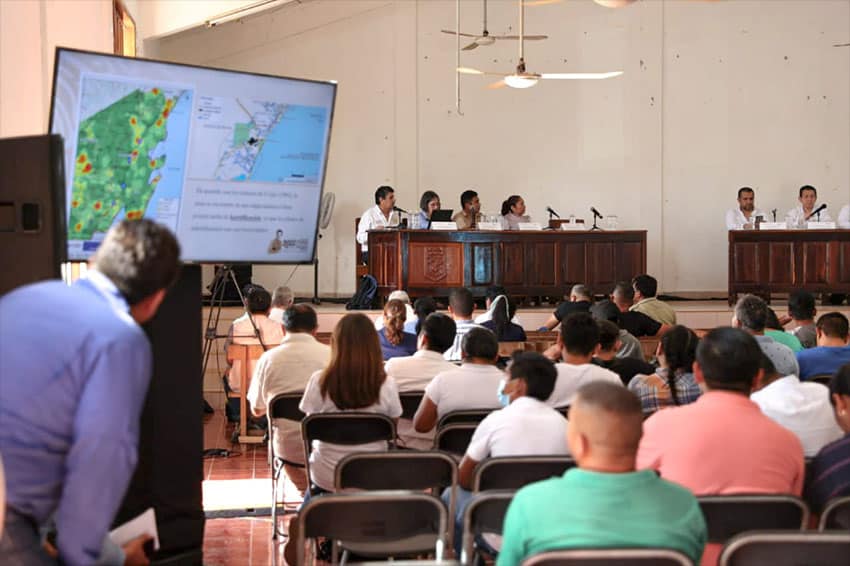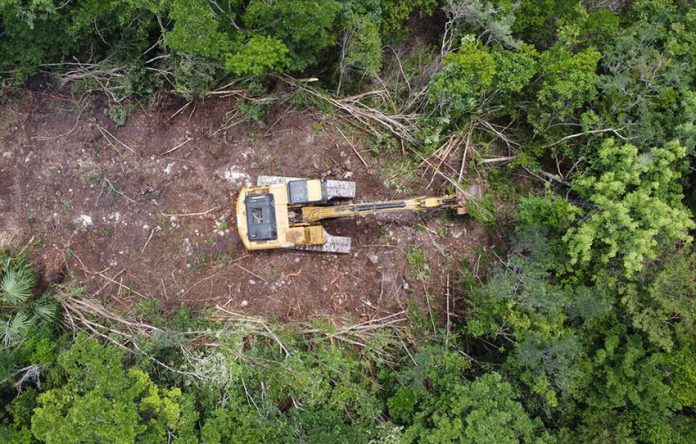A study carried out by the National Autonomous University (UNAM) has concluded that the Tulum-Chetumal section of the Maya Train railroad is environmentally viable, but Greenpeace warned that the project places jungle along the route at “serious risk.”
Citing an environmental impact statement (EIS) prepared by UNAM’s Institute of Engineering at the federal government’s request, the National Tourism Promotion Fund (Fonatur) said in a statement Tuesday that section 6 of the 1,500-kilometer-railroad is “environmentally viable” as it “complies with Mexican laws and international treaties in the area.”
Fonatur, which is managing the US $10 billion project, also said that “complementary works” such as 138 wildlife crossings will be built along the 255-kilometer Tulum-Chetumal section, which will pass through the Quintana Roo municipalities of Tulum, Felipe Carillo Puerto, Bacalar and Othón P. Blanco.
The section, which will be built by the army and is expected to cost some 70 billion pesos (US $3.5 billion), has already been granted provisional approval.

At a meeting in a Felipe Carillo Puerto community on Tuesday at which the section 6 EIS was presented to local residents, Fonatur officials and UNAM Institute of Engineering academics highlighted that the EIS “provides for programs and actions” to compensate for “possible” environmental impacts “during the preparation of the site, construction, operation and maintenance of the project,” Fonatur said in its statement.
It said that some of the impacts “would be temporary and others can be prevented, mitigated and/or compensated.”
For its part, Greenpeace México, which carried out its own technical analysis of sections 6 and 7 of the Maya Train project, offered a scathing assessment of the environmental impact statements prepared for those routes, the latter of which will run between Bacalar and Escárcega, Campeche.
“Hand in hand with experts, Greenpeace meticulously reviewed the environmental impact statements and found that once again, the National Tourism Promotion Fund is presenting insufficient, false and inaccurate information,” the environmental organization said in a statement published Monday.
Greenpeace said that sections 6 and 7 are slated to run through “regions of major importance for conservation” and that its technical analysis concluded that the Mayan Jungle would be placed at “serious risk.”
“Section 6 is located just 2.5 kilometers from the Sian Ka’an Natural Protected Area (ANP), and therefore it’s very probable that the negative impacts … will affect this ANP, which was registered as a UNESCO World Heritage Site,” Greenpeace said after noting that the Tulum-Chetumal stretch will also pass through areas with cenotes (natural sinkholes) wetlands, lagoons and mangroves.
It also said that section 7 will negatively impact “the area of influence of the Mexican Caribbean Biosphere Reserve” and the UNESCO-protected ancient Mayan city of Calakmul, among other areas.
Greenpeace – which also challenged the EIS for the contentious Playa del Carmen-Tulum stretch of the railroad – called on the government to “stop pretending and protect the Mayan Jungle,” of which almost 1,500 hectares need to be cleared for section 6 alone.

The environmental impact statements for both sections 6 and 7 should be rejected because the two projects pose risks to heritage sites and wildlife corridors that are “crucial for the preservation of endangered species,” the organization said, adding that they “violate international treaties and human rights.”
President López Obrador has repeatedly played down the impact the railroad will have on the natural environments of the five states – Tabasco, Campeche, Yucatán, Quintana Roo and Chiapas – through which it will run.
He asserts that the railroad – which has faced a range of legal challenges since construction began in 2020 – will spur social and economic development in what he describes as Mexico’s long-neglected southeast, and has pledged that it will begin operations in 2023.
However, two people working on the ambitious project claimed earlier this year that it won’t be finished while the current federal government is in office, if at all. Several construction companies offered a similar opinion last year.
With reports from Sin Embargo, La Jornada Maya, Reforma and Expansión
